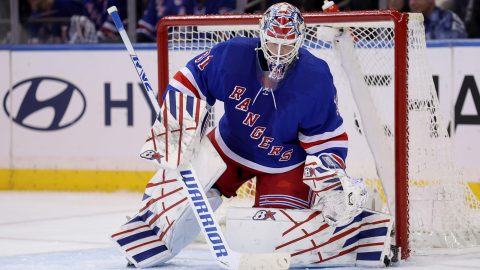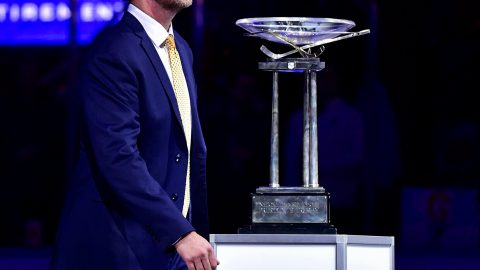Here is the second of two pieces looking at first-half stats
that we think best isolate luck (both good and bad) so we can get a lead on
which pitchers and hitters are most likely to regress and progress for the
balance of the year.
For hitters, we look at outliers (relative to personal
history and league averages) in batting average on balls in play (BABIP),
average with runners in scoring position (BARISP) and percentage of fly balls
that become home runs (HR/FB).
We judge pitchers by Fielding Independent (FIP) ERA (minus
actual ERA), HR/FB rates and defensive efficiency rating (DER, percentage of
balls in play that become outs). To get the best read on DER outliers, we
factor in a pitcher’s rate of line drives allowed (relative to league average).
Remember, about 75 percent of line drives are hits.
Our focus here is on “lucky” players – those our
projection model says should fare significantly worse in the second half as
their performance in these key metrics regresses toward their individual and/or
league averages. Thus, we do away with the standard “Buy, Sell, Hold”
format. All of the below are “Sells” unless otherwise indicated.
All stats cited are first-half (through the All-Star break)
only.
BABIP
I’m not going to throw a name up here just to do it. Sure,
there are guys with very high BABIP. David
Wright is .426 — that is unsustainable, but not wildly so. Wright is
regularly over .340. Matt Kemp
(.391) also is regularly well above average (.300) on BIP. The same is true
with guys behind them on the list of BABIP leaders. Since they’re not that far
above their averages, I can’t say to sell any of them.
BARISP
Yunel Escobar,
SS, Braves: He’s about 100 points over his career average with RISP at .410.
Expect his RBI rate to decline about 25 percent post-break.
Bobby Abreu, OF,
Angels: At .387, he’s about 100 points over his rate the last two years, too.
He will not maintain his 100-RBI pace without boosting that homer rate.
HR/FB
Ben Zobrist, OF,
Rays: Zobrist qualifies at multiple positions. But has he developed more power
(23 percent of fly balls are homers) than Ryan
Howard (21.2 percent)? I buy Zobrist having above-average power but not
elite power.
Joe Mauer, C,
Twins: Another guy out-powering Howard (23.9 percent). Keep in mind that
Howard’s current rate is about twice average. Yes, he’s great, and power can
emerge suddenly and dramatically with great players. But skepticism here is
healthy.
Brandon Inge, 3B,
Tigers: Love the catcher eligibility, but 22.1 percent homers (career average
is 10.9 percent)? All attributable to some subtle change in his stance? Seems
fishy. Lock in those profits now.
FIP minus ERA
J.A. Happ, P,
Phillies: He’s 1.66 runs per game better than his peripherals suggest. There’s
no big-league track record to give us comfort that he defies the BIP odds.
Kevin Millwood,
P, Rangers: Everyone is skeptical, so good luck finding a buyer. The price is
so low relative to performance that you might be better off buying into the
chance he’s skilled/clutch enough to sustain an actual ERA 1.36 runs better
than his FIP ERA.
Note that I ignore Matt
Cain (1.46 runs per game better than his FIP says) because I’m tired of
putting Cain on all these sell lists. To repeat what I wrote recently, great
stuff might buy you more than your fair share of good luck.
HR/FB
Zack Greinke, P,
Royals: He’s struggled lately – 4.00-ish ERA with a 1.40-plus WHIP since June
1. If he keeps allowing that many baserunners, his ERA will rise because he
will not continue to allow homers on just 3.7 percent of fly balls (average is
10.5 percent).
Tim Lincecum, P,
Giants: He’s not throwing nearly as hard as the last two years — off by about
a mile and a half and down to 92.6 on his average heater. His HR/FB is always
good, but at 4.6 percent, it’s more than a third lower than his career average.
DER
Jarrod Washburn,
P, Mariners: If you’re just average or worse at preventing line drives, you
shouldn’t be well above average in DER (the average there is about .700).
Washburn gets outs on .756 of balls in play despite a sub-par 21.9 percent
line-drive rate. Yes, the Mariners have the best team DER in the AL — .711.
But Washburn doesn’t have peripherals to support being better than that
Mariners average.
Scott Feldman, P,
Rangers: His line-drive rate is 19.4, so his DER should be closer to .700, not .760. Again, I realize that the Rangers
finished the first half as the second-best defensive team in the league, but
overall they’re only .706 (the league DER at the break was .694).



